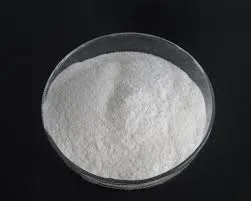
Nov . 27, 2024 04:15 Back to list
Effective Methods for Dissolving HPMC in Water for Improved Results
How to Dissolve HPMC in Water A Comprehensive Guide
Hydroxypropyl Methylcellulose (HPMC) is a versatile cellulose ether that is widely used in various industries, including pharmaceuticals, food, and construction. It serves as a thickening agent, binder, and film-forming agent, making it indispensable in many formulations. However, properly dissolving HPMC in water can be challenging if not done correctly. This article will guide you through the steps to effectively dissolve HPMC in water, ensuring optimal performance in your applications.
Understanding HPMC
HPMC is an inert, non-toxic material derived from natural cellulose. It is available in different grades, with varying degrees of gelling and viscosity properties. These characteristics can affect how you should dissolve it in water. Generally, HPMC is soluble in cold water and forms a gel-like consistency upon hydration.
Materials Needed
- HPMC powder - Distilled water at room temperature - A mixing container - A mechanical stirrer or whisk - Hot water (optional) - A sieve (optional)
Step-by-Step Dissolving Process
1. Preparation of Water Start with distilled water to avoid impurities that could potentially interfere with the dissolution process. Room temperature water is preferable, as it helps avoid premature gelling.
how to dissolve hpmc in water

2. Measuring HPMC Accurately measure the amount of HPMC powder you need according to your formulation. A common starting ratio is 2% HPMC to water, but this can vary based on the desired viscosity and application.
3. Mixing Method - Dry Mixing For best results, it’s helpful to begin by gradually sprinkling the HPMC powder over the surface of the water rather than dumping it in all at once. This helps prevent clumping. - Stirring Using a mechanical stirrer or whisk, gently mix the HPMC into the water. If you notice any lumps forming, continue stirring vigorously until those lumps disappear. The goal is to achieve a smooth consistency.
4. Using Hot Water (Optional) If you find the HPMC is not dissolving well at room temperature, you can use warm water (not boiling). Heat the water to about 50°C (122°F) and then follow the same mixing procedure. The heat can help to hydrate the HPMC more effectively, but be cautious, as too high a temperature can cause gelling.
5. Resting Period After mixing, allow the solution to rest for about 30 minutes. This resting period enables complete hydration of the HPMC and helps achieve a uniform viscosity.
6. Straining the Mixture (Optional) If there are still undissolved particles after the resting period, you can pass the solution through a sieve to remove any lumps. This is particularly useful if the final application requires a smooth texture.
7. Final Adjustments After straining, check the viscosity of your solution. If it is too thick, you can add more distilled water to achieve your desired consistency. Conversely, if it is too thin, you may need to add a little more HPMC, repeating the mixing process.
Conclusion
Dissolving HPMC in water is a straightforward process when approached with care. Following the steps outlined above will help you achieve a well-dispersed solution suitable for your specific needs. Remember to adapt the technique to the specific grade of HPMC you are using and the requirements of your application. By understanding how to manipulate water temperature and mixing methods, you can unlock the full potential of HPMC in your formulations. Whether you are in the pharmaceutical, food, or construction industry, mastering the dissolution of HPMC will enhance the quality and performance of your products.
-
HPMC for Tile Adhesive: Superior Bonding & Workability
NewsAug.30,2025
-
Premium Cellulose Ether: Effective Liquid Thickener Solutions
NewsAug.29,2025
-
HPMC for Tile Adhesive: Enhanced Bonding & Workability
NewsAug.28,2025
-
tile-bonding-additives-for-stronger-bonds
NewsAug.22,2025
-
construction-grade-rdp-for-wholesale-needs
NewsAug.22,2025
-
trusted-hec-supplier
NewsAug.22,2025







